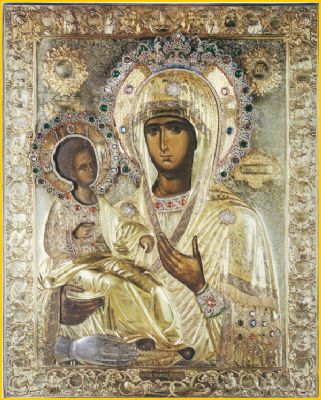|
|||
|---|---|---|---|
| This weekly bulletin insert complements the curriculum published by the Department of Christian Education of the Orthodox Church in America. This and many other Christian Education resources are available at http://dce.oca.org. | |||

The Church remembers this famous icon painted by Saint John of Damascus in thanks to the Theotokos for a miraculous healing. Saint John lived in a time when it was dangerous to be an outspoken, dedicated lover of icons, as he was. Born in 674 to devout Christians, John always lived under Muslim rule. His father held a high position as the financial officer for the governing caliph. In fact, John would succeed his father in that post. In addition to finance he was well-versed in theology, astronomy, mathematics and musical composition. His far-sighted father had bought the freedom of a captive, a very learned monk from Sicily, taken in a raid on the coast of Italy. John's father gave him the position of tutor to John, who made rapid progress as a student. In 726, perhaps influenced by Muslim thinking, the Byzantine Emperor Leo III "the Isaurian" issued an edict prohibiting the veneration of icons. He ignored the protests of the Patriarch of Constantinople, a slight which showed how influential iconoclasm had become in the Byzantine court. John, in response, wrote the first of three treatises "against those decrying the Holy Images." When the emperor followed his first edict with another forbidding not only veneration but even the public display of icons, John wrote his second treatise, and then a third. What made John's writing especially effective was his ability to put his thoughts in simple language. Though his thinking was brilliant, he managed to make it understandable to anyone willing to pay close attention. His writings rallied many people to the cause of preserving icon veneration, which the nervous iconoclast emperor rightly perceived as a threat. Emperor Leo acted quickly and deviously. He accused John to the caliph, calling his writings "treasonous." The caliph ignored John's protests of innocence, and ordered that his right hand—his writing hand—be cut off. In agony, John begged to be given his cut-off hand. Holding it close to his wrist, he prostrated himself before the icon of the Mother of God and implored her to heal him. After hours of intense prayer he fell asleep, and dreamed that the Theotokos promised to heal him, and urged him to work hard with his restored hand. When he awoke his hand was healed, with only a red scar at the wrist. The "Icon of the Three Hands" was John's expression of thanks to the Theotokos. To the usual depiction of Christ and His Mother, John added a third hand made of silver. John also honored the Mother of God's directive to work hard. He retreated to a monastery near Jerusalem, and continued to write commentaries, theological treatises and hymns. One of the best-known of his hymns is "All of Creation Rejoices in You, O Full of Grace." Each time we sing it, during the Liturgy of Saint Basil, we join John of Damascus in his grateful dedication to the Mother of Our Lord. |
|||
